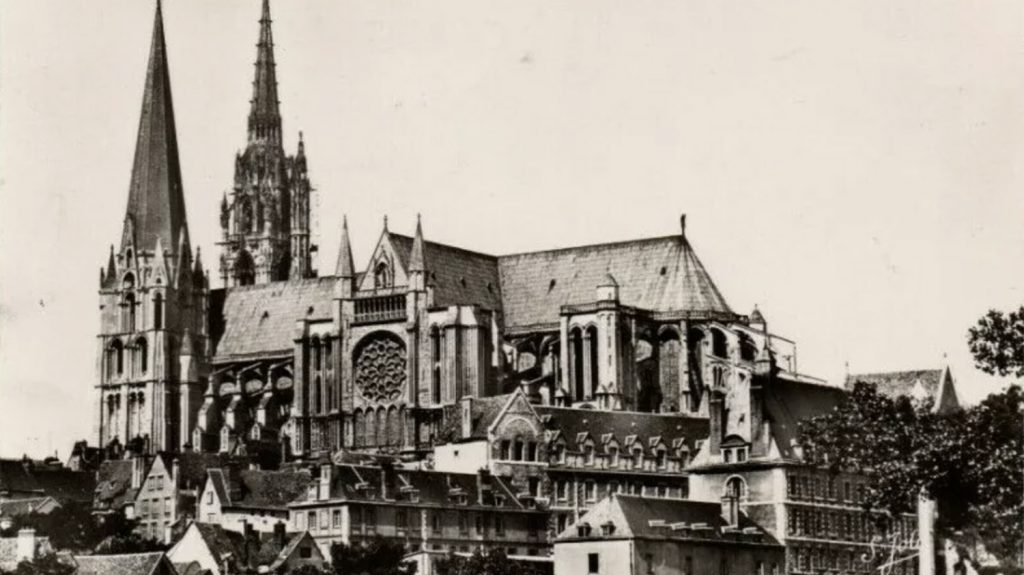The medieval cathedral of Chartres (above) was saved from shelling by American artillery today in 1944, during the Allied invasion of Normandy in the Second World War. Weeks after the Normandy landings, the battle raged around Chartres, and the US military believed the cathedral towers were occupied by German snipers or observers. Learning the plan to destroy the cathedral, Colonel Welborn Griffith and his driver went behind enemy lines to investigate. Searching the cathedral and finding it empty, Griffith reported back and the plan to bombard was withdrawn. That afternoon, in the nearby town of Lèves, he was killed by enemy machine gun fire. He was posthumously awarded the French Croix de Guerre and the Légion d’Honneur, and a plaque on the spot where he died commemorates the man who risked his life to save Notre-Dame de Chartres.
It is the feast of St Roch, who became a Franciscan as a young man, travelled from France to Italy, and cared for people stricken with the plague. When he himself was infected, he retreated to a hut in the forest, where (according to legend) a miraculous spring supplied him with running water, and a friendly dog with food. He died today in Italy sometime in the 1370s.
Today in 944, the famous Mandylion of Edessa, believed to be a supernatural image of the face of Christ, was carried in triumphant procession around the walls of Constantinople. The icon had arrived in the city the previous day, and was greeted by ecstatic crowds, as though Christ himself had come to live among them. It had been extracted by a military expedition from the town of Edessa, in Mesopotamia, where it had been treasured for several centuries. The event is still celebrated as a feast day in the Eastern Orthodox Church. Modern devotees of the Shroud of Turin believe that the Mandylion and the Shroud are the same object, and that the image came to the West after the sack of Constntinople in 1204.
‘They went into the city, forming a procession with lofty psalms, hymns and spiritual chants and the light of countless torches as they made their way through the centre of the city, believing that in this way the city would be made holier and stronger, and would be kept unharmed and unassailable for all time. Everyone who could ran towards the spectacle, and the crowds gathered together from all over like huge waves.’ Narratio de Imagine Edessena, 10th century, translated by Mark Guscin
The flamboyant revivalist preacher Charles Finney died today in 1875. Finney made his reputation (and fired up his critics) by leading revival meetings in upstate New York in the 1820s and 30s in what became known as the Second Great Awakening (the first had been under the preaching of George Whitefield in the previous century). His preaching was powerful, emotional, spontaneous and theatrical, seeking a decision from his listeners, who were invited to come forward and sit in the ‘anxious seat’, where they could surrender to the will of God. Finney was criticised for this and other ‘irregularities’ in his ministry, such as allowing women to pray in public meetings, and banning slaveholders from receiving communion. Many of his methods were inherited by the mass evangelists of the 20th century.
‘You will get your “wages”; just what you have earned, your due; nothing more, nothing less; and as the smoke of your torment, like a thick cloud, ascends forever and ever, you will see written upon its curling folds, in great staring letters of light, this awful word, wages, wages, WAGES!’ Charles Finney, preaching on the text, ‘the wages of sin is death’
John Wesley, on his never-ending preaching tour, found himself in the north of England today in 1748, under incessant rain.
‘Soon after twelve I preached near the Market-place in Stockton, to a very large and very rude congregation; but they grew calmer and calmer, so that long before I had done, they were quiet and serious. Some gentlemen of Yarm earnestly desired, that I would preach there in the afternoon. I refused for some time, being weak and tired, so that I thought preaching thrice in the day, and riding upward of fifty miles, would be work enough. But they would take no denial. So I went with them about two o’clock, and preached at three in the Market-place there, to a great multitude of people gathered together at a few minutes’ warning. About seven I preached in the street at Osmotherley. It rained almost all the time; but none went away. We took horse about five.’ The Journal of John Wesley
Image: public domain
